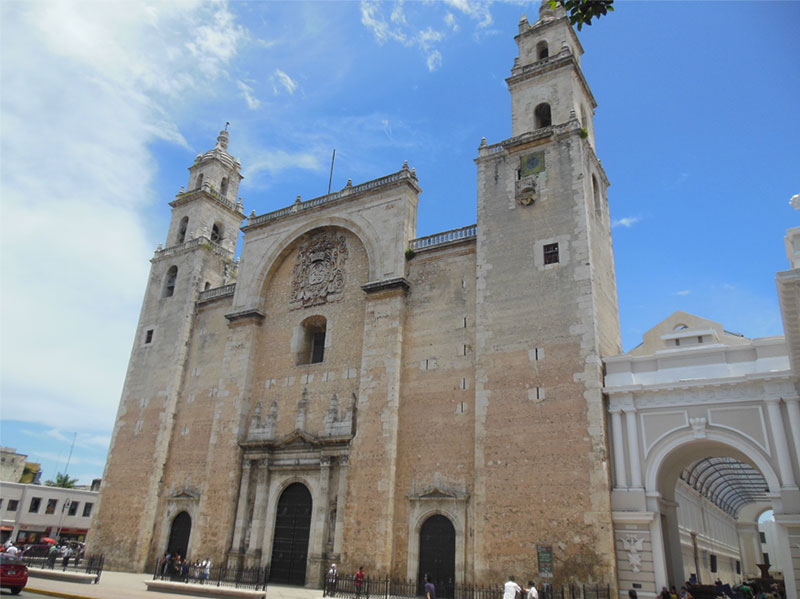In the heart of Mérida, Yucatán, stands a testament to centuries of history, culture, and faith., The beautiful Cathedral of San Ildefonso. With its towering bell towers, stone facade, and serene interior, this magnificent cathedral is not only a religious icon but also a symbol of the city's enduring legacy. The cathedral was built on the site of Mayan ruins T'ho and is seat of the bishopric of Yucatán. It was the first cathedral to be finished on the mainland of the Americas, and the only one to be entirely built during the 16th century. It is a unique monument with clear antecedents in Andalucia.
A Glimpse into the Past
The Cathedral of San Ildefonso holds a storied past that dates back to the early days of Spanish colonization in the Americas. Construction began in 1562 under the direction King Felipe II with the authorization of Pope Pío IV, utilizing the labor of indigenous Mayan workers, the work was under of supervision of Pedro de Aulestia and finished by Juan Miguel de Agüero and Gregorio de la Torre in 1598. Over the centuries, the cathedral underwent several renovations and expansions, culminating in its current grandeur.
After a blueprint of the Cathedral from 1574 it has been contemplated that Francisco Montejo el Mozo is buried at San Idelfonso and not at the "Convento Grande de San Francisco".
The bishopric of Yucatán had an uncertain start. The Yucatán peninsula was explored by Francisco Hernandez de Córdoba and Juan de Grijalva on behalf of Diego Velazquez de Cuellar, the adelantado of Cuba, in 1517 and 1518. The creation of a diocese in the recently discovered country was urged by Velazquez, who presumed to have jurisdiction over the region and hoped to colonize it. An episcopal see known as "Carolense" was indeed created by Pope Leo X in 1519 (later renamed Our Lady of Remedies "Nuestra Señora de los Remedios" by Clement VII). But said diocese was not implemented in the territory of Yucatán but in that of Tlaxcala instead and later on was moved to Puebla. It cannot therefore be considered the predecessor of the diocese of Yucatán.
The diocese of Yucatán proper, named "Yucatan and Cozumel," was created by Pius IV in 1561. St. Ildephonsus of Toledo was invoked as the patron. Two prelates for the new see were nominated in succession by the Spanish Crown but neither could be consecrated for entirely accidental reasons. A third candidate, fray Francisco Toral, was eventually consecrated and took possession on August 14, 1562. He was the first of a long line of bishops, later archbishops, of Yucatán.
Architecture
As you approach the cathedral, you're greeted by its imposing facade, a masterful blend of Spanish Renaissance and Plateresque styles. Intricate carvings, decorative motifs, and religious symbols, showcasing the skilled craftsmanship of the artisans who brought the cathedral to life.
The cathedral's interior is equally breathtaking, with soaring vaulted ceilings, ornate altars, and exquisite religious artwork adorning its walls. Sunlight filters through stained glass windows, casting a kaleidoscope of colors across the marble floors and wooden pews, creating an atmosphere of reverence and tranquility.
The building consists of three main spaces, one central and two lateral ones. It has three chapels and the sacristy. It originally had five chapels, but they were demolished. It has two towers in Moorish style and a dome adorned with a botareles arch.
Spiritual Center
Beyond its architectural beauty, the Cathedral of San Ildefonso holds profound spiritual significance for the people of Mérida. As the seat of the Archdiocese of Yucatán, it serves as a place of worship and pilgrimage, drawing faithful devotees and curious visitors alike to its hallowed halls.
On the main altar there is a large image of the crucified Christ, known as the “Christ of Unity” considered the largest indoor wooden image of Jesus Christ crucified in existense, the work of the Spanish artist Lapayese del Río and was made to replace an older altarpiece.
Throughout the year, the cathedral hosts religious ceremonies, including Masses, weddings, baptisms, and religious festivals, offering worshippers an opportunity to connect with their faith and heritage in a sacred setting.
Cultural Heritage
Beyond its religious significance, the Cathedral of San Ildefonso is a cultural treasure that reflects the diverse influences that have shaped Yucatecan identity over the centuries. Its architecture, artwork, and religious rituals bear traces of both Spanish and indigenous traditions, serving as a tangible reminder of the region's complex history.
In the bustling streets of Mérida, amidst the hustle and bustle of daily life, the Cathedral of San Ildefonso stands as a timeless icon of faith, history, and culture. Whether you're drawn to its architectural splendor, spiritual significance, or cultural heritage, a visit to this majestic cathedral is sure to leave a lasting impression, inviting you to ponder the mysteries of the past and find solace in the beauty of the present.

